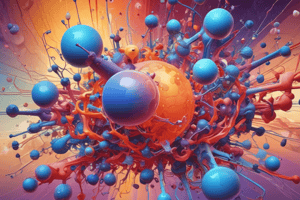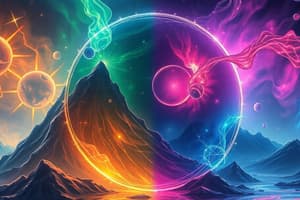Podcast
Questions and Answers
What characterizes a solid state of matter?
What characterizes a solid state of matter?
- Has a definite volume and shape (correct)
- Has no definite shape or volume
- Molecules move freely and rapidly
- Particles are farther apart than in liquids
Which statement about gases is true?
Which statement about gases is true?
- Gas particles are immobile and resist changes
- Molecules in gases are closely packed
- Gases take the shape of their container (correct)
- Gases have a definite shape and volume
What differentiates liquids from solids?
What differentiates liquids from solids?
- The attractive forces in liquids are weaker than in solids (correct)
- Molecules in liquids are closely packed like in solids
- Liquids have a definite shape
- Liquids do not retain a definite volume
What is a characteristic of plasma?
What is a characteristic of plasma?
Which of the following describes a Newtonian fluid?
Which of the following describes a Newtonian fluid?
Which property of gases results from weak forces of attraction?
Which property of gases results from weak forces of attraction?
What happens to gas volume when temperature increases?
What happens to gas volume when temperature increases?
What is a thixotropic liquid?
What is a thixotropic liquid?
Which state of matter has a definite volume but no definite shape?
Which state of matter has a definite volume but no definite shape?
Solids have molecules that are free to move in all directions.
Solids have molecules that are free to move in all directions.
Name the state of matter that is a collection of gaseous particles at extremely high temperatures.
Name the state of matter that is a collection of gaseous particles at extremely high temperatures.
The state of matter that can be compressed and has no definite shape or volume is called __________.
The state of matter that can be compressed and has no definite shape or volume is called __________.
Match the states of matter with their proper characteristics:
Match the states of matter with their proper characteristics:
Which statement best describes thixotropic liquids?
Which statement best describes thixotropic liquids?
Plasma is the least common form of matter in the universe.
Plasma is the least common form of matter in the universe.
What are the attractive forces like in gases?
What are the attractive forces like in gases?
The name of the British Physicist who identified the fourth state of matter in 1879 as radiant matter.
The name of the British Physicist who identified the fourth state of matter in 1879 as radiant matter.
Flashcards
Solid State
Solid State
A state of matter with a fixed volume and shape, due to strong attractive forces between particles, allowing it to resist changes in shape and volume. Particles are closely packed and vibrate, producing sound.
Gas State
Gas State
A state of matter with no fixed shape or volume, taking on the shape of its container. Particles move freely with weak attractive forces, expanding or contracting with temperature and pressure changes.
Liquid State
Liquid State
A state of matter with a fixed volume but taking on the shape of its container. Particles are less densely packed than solids and move more freely with weaker attractive forces.
Newtonian Fluid
Newtonian Fluid
Signup and view all the flashcards
Thixotropic Liquid
Thixotropic Liquid
Signup and view all the flashcards
Plasma State
Plasma State
Signup and view all the flashcards
Phases of Matter
Phases of Matter
Signup and view all the flashcards
Water
Water
Signup and view all the flashcards
Study Notes
Phases of Matter
- Matter exists in four primary phases: solid, liquid, gas, and plasma.
- Solids have a definite volume and shape. Strong attractive forces between atoms/molecules resist change in shape or volume. Atoms are in a fixed position and vibrate, producing sound. The molecules/atoms/ particles are closely packed and held together by very strong forces.
- Liquids have a definite volume but take the shape of their container. Attractive forces are weaker than in solids allowing particles to flow, while holding a constant volume. The molecules in liquids are less densely condensed and free to move. Liquids can be ideal, meaning they remain viscous regardless of shear stress applied. Other liquids are thixotropic, meaning they resist flowing until agitated, then flow like liquids.
- Gases have no definite volume or shape. They take the shape and volume of their container. Weak attraction forces allow the particles to move freely in all directions. Pressure and temperature affect their volume. Gas molecules move freely, offering no resistance to changes in shape or volume. The molecules in a gas are much farther apart than in solids or liquids.
- Plasmas are the fourth state of matter. They are a collection of gaseous particles at extremely high temperatures (over 100,000°C). They have no definite volume or shape. Particles are electrically charged and move freely. Plasmas are abundant in the universe, for example in lightning, auroras, and some stars.
Studying That Suits You
Use AI to generate personalized quizzes and flashcards to suit your learning preferences.




